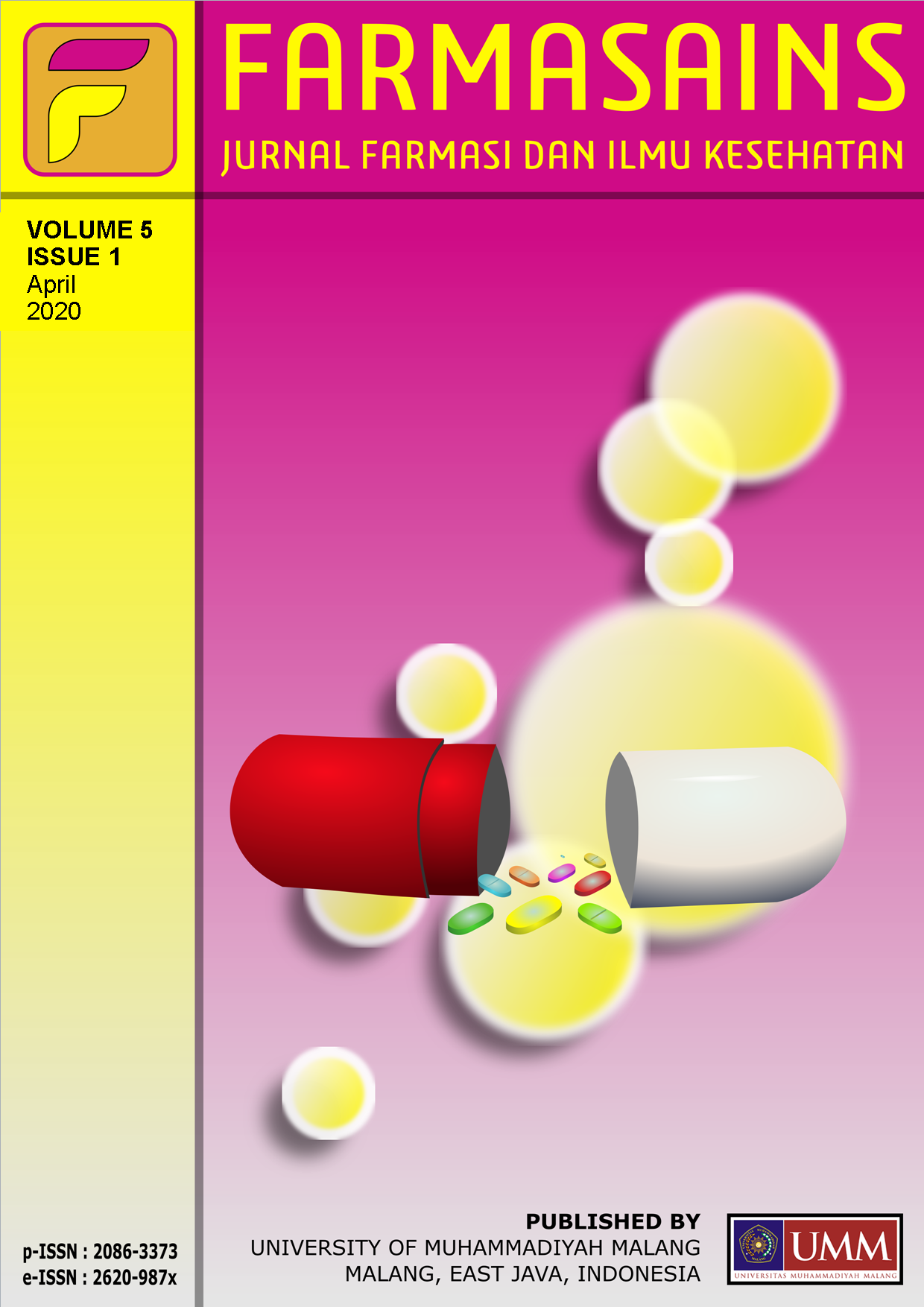In vitro testing of emulgel with a combined extract of Sansevieria trifasciata Prain. and Curcuma longa Linn. against the Candida albicans
DOI:
https://doi.org/10.22219/farmasains.v5i1.13185Keywords:
Sansevieria trifasciata Prain extract, Curcuma longa Linn. extract, Emulgel, Candida albicans, Antifungal activityAbstract
Content of flavonoids in Sansevieria trifasciata Prain. and curcumonoids in
Curcuma Longa Linn. can inhibit the growth of the fungi Candida albicans in the wound. An innovative formulation was made that form a combination of antifungal extracts S. trifasciata and C. longa in the form of emulgel, which is easy to absorb and can moisturize the skin. The purpose is to determine the effect of antifungal activity of emulgel preparations using S. trifasciata extract with a concentration of 0%; 5%; and 10%, and C. longa 10% against C. albicans. S. trifasciata and C. longa extracts are formulated into emulgel in three formulas, F1 (C. longa 10%); F2 (S. trifasciata 5%; C. Longa 10%); and F3 (S. trifasciata 10%; C. Longa 10%). Antifungal activity was tested using the diffusion well method. The results of antifungal activity research showed inhibition zone diameter, inhibitory activity, and effectiveness. There were no significant differences in formula 1, formula 2, formula 3, but there were significant differences with positive controls. Variation the concentration of S. trifasciata 5% and 10% has no significant effect on the inhibitory zone of the C. albicans, but the three emulgel of S. trifasciata and C. Longa extract had antifungal activity on the growth of C. albicans.
Downloads
References
Anwar, E., Ramadon, D., & Harmita. (2014). Formulation and Evaluation of Gel and Emulgel of Chili Extract (Capsicum frustencens L.) as Topical Dosage Form. International Journal of Pharmacy and Pharmaceutical Sciences, 6(Suppl. 3), 13-16. Haneefa, K. P. M., Easo, S., Hafsa, P. V., Mohanta, G. P., & Nayar, C. (2013). Emulgel: An Advanced Review. Journal of Pharmaceutical Science and Research, 5(12), 254-258. Hartati, S. Y. (2013). Khasiat Kunyit sebagai obat tradisional dan manfaat lainnya. Warta Puslitbang Perkebunan, 19(2), 5-9. Khan, N., Shreaz, S., Bhatia, R., Ahmad, S. I., Muralidhar, S., Manzoor, N., & Khan, L. A. (2012). Anticandidal activity of curcumin and methyl cinnamaldehyde. Fitoterapia, 83(3), 434-440. doi:10.1016/j.fitote.2011.12.003 Kim, M. K., Choi, G. J., & Lee, H. S. (2003). Fungicidal property of Curcuma longa L. rhizome-derived curcumin against phytopathogenic fungi in a greenhouse. Journal of Agricultural and Food Chemistry, 51(6), 1578-1581. doi:10.1021/jf0210369 Komala, O., Yulia, I., & Pebrianti, R. (2012). Uji efektivitas ekstrak etanol daun lidah mertua (Sansevieria trifasciata Prain) terhadap khamir Candida albicans. Fitofarmaka, 2(2), 146-152. doi:10.33751/jf.v2i2.169 Lima, C. F., Pereira‐Wilson, C., & Rattan, S. I. S. (2011). Curcumin induces heme oxygenase‐1 in normal human skin fibroblasts through redox signaling: Relevance for anti‐aging intervention. Molecular nutrition & food research, 55(3), 430-442. doi:10.1002/mnfr.201000221 Lombogia, B., Budiarso, F., & Bodhi, W. (2016). Uji daya hambat ekstrak daun lidah mertua (Sansevieriae trifasciata folium) terhadap pertumbuhan bakteri Escherichia coli dan Streptococcus sp. Jurnal e-Biomedics, 4(1). doi:10.35790/ebm.4.1.2016.12230 Neelofar, K., Shreaz, S., Rimple, B., Muralidhar, S., Nikhat, M., & Khan, L. A. (2011). Curcumin as a promising anticandidal of clinical interest. Canadian Journal of Microbiology, 57(3), 204-210. doi:10.1139/W10-117 Robison, A. J., & Nestler, E. J. (2011). Transcriptional and epigenetic mechanisms of addiction. Nature reviews neuroscience, 12(11), 623-637. . https://doi.org/10.1038/nrn3111 Sa'diah, S. (2004). Pemeriksaan Flavonoid Dan Asam Fenolat Ekstrak Etanol Dan Fraksi Herba Sambiloto (Andrographis paniculata Ness, Acanthaceae) Serta Uji Aktivitas Antibakteri Dan Antifungi. Ekologia, 4(2), 47-51. Sharma, R. J., Aqil, F., Jeyabalan, J., Gupta, R.C., & Singh, I P. (2013). Quantitative analysis of Eugenia jambolana (Willd. ex O. Berg) for its major anthocyanins by densitometry. JPC-Journal of Planar Chromatography-Modern TLC, 26(4), 363-369. doi:10.1556/JPC.26.2013.4.13 Ulya, Z. A. & Rusman. (2012). Cegah diabetes dengan rempeyek lidah mertua. Jurnal Pendidikan Dompet Dhuafa, 2(1), 1-8. Wientarsih, I., Widhyari, S. D., & Aryanti, T. (2013). The combination of curcumin with zinc in feed as alternatif therapy collibaciilosis in broiler. Jurnal Veteriner, 14(3), 327-334.
Downloads
Published
How to Cite
Issue
Section
License
Authors who publish with this journal agree to the following terms:
a. Authors retain copyright and grant the journal right of first publication with the work simultaneously licensed under a Creative Commons Attribution License that allows others to share the work with an acknowledgement of the work's authorship and initial publication in this journal.
b. Authors are able to enter into separate, additional contractual arrangements for the non-exclusive distribution of the journal's published version of the work (e.g., post it to an institutional repository or publish it in a book), with an acknowledgement of its initial publication in this journal.
c. Authors are permitted and encouraged to post their work online (e.g., in institutional repositories or on their website) prior to and during the submission process, as it can lead to productive exchanges, as well as earlier and greater citation of published work (See The Effect of Open Access).













